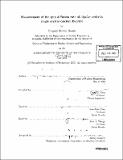Measurement of the spin diffusion rate of dipolar order in single crystal calcium fluoride
Author(s)
Boutis, Gregory Steven, 1975-
DownloadFull printable version (2.599Mb)
Other Contributors
Massachusetts Institute of Technology. Dept. of Nuclear Engineering.
Advisor
David G. Cory.
Terms of use
Metadata
Show full item recordAbstract
This thesis reports on the first measurement of the spin diffusion rate of a two-spin correlated state, known as dipolar order, in a single crystal of calcium fluoride. The experimental results for the component of the spin diffusion rate parallel with the azimuthal axis are ... for the [001] direction and ... for the [111] direction. These rates are significantly faster than those for Zeeman order and are also faster than theories have predicted. The standard method of measuring diffusion in magnetic resonance is to encode a spatial modulation of magnetization in a sample and then measure it's attenuation over time. The difficulty in measuring spin diffusion in solid crystals by these scattering methods is that the spin diffusion rate is very slow (of order 1 x 10⁻¹² cm²/s) and hence the displacement of coherence is very small. The experimental challenge for probing these dynamics is that a modulation must be created with a wavelength on these length scales. To perform the measurement a special probe was developed with a gradient coil constant of 370±10.5[G/cmA]. A special holder was designed for holding the 1mm³ sample in addition to a gradient switcher for switching pulsed currents through the coil. The peak pulsed gradient strengths ranged from 28 to 85 T/m and the spatial wavelengths generated ranged from 1[mu] to 0.5 [mu]/tm. (cont.) Additional work focuses on correcting for finite pulse widths effects, phase transients and other pulse errors in a time-reversal multiple-pulse cycle known as the magic-echo sequence. The highest resolution achieved was a line-width of 0.5 Hz in a single crystal of calcium fluoride whose natural line-width was approximately 45 kHz, a reduction by 5 orders of magnitude. A phase alternating scheme for generating and detecting high order n-spin azimuthal spin correlations ... was also investigated. The relaxation times of 2, 3 and 4 spin correlations were was found to be comparable to that of dipolar order.
Description
Thesis (Ph. D.)--Massachusetts Institute of Technology, Dept. of Nuclear Engineering, 2002. Includes bibliographical references (leaves 69-74).
Date issued
2002Department
Massachusetts Institute of Technology. Department of Nuclear Engineering; Massachusetts Institute of Technology. Department of Nuclear Science and EngineeringPublisher
Massachusetts Institute of Technology
Keywords
Nuclear Engineering.